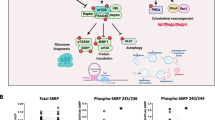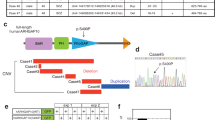Abstract
AKT-GSK3β signaling is a target of lithium and as such has been implicated in the pathogenesis of mood disorders. Here, we provide evidence that this signaling pathway also has a role in schizophrenia. Specifically, we present convergent evidence for a decrease in AKT1 protein levels and levels of phosphorylation of GSK3β at Ser9 in the peripheral lymphocytes and brains of individuals with schizophrenia; a significant association between schizophrenia and an AKT1 haplotype associated with lower AKT1 protein levels; and a greater sensitivity to the sensorimotor gating–disruptive effect of amphetamine, conferred by AKT1 deficiency. Our findings support the proposal that alterations in AKT1-GSK3β signaling contribute to schizophrenia pathogenesis and identify AKT1 as a potential schizophrenia susceptibility gene. Consistent with this proposal, we also show that haloperidol induces a stepwise increase in regulatory phosphorylation of AKT1 in the brains of treated mice that could compensate for an impaired function of this signaling pathway in schizophrenia.
This is a preview of subscription content, access via your institution
Access options
Subscribe to this journal
Receive 12 print issues and online access
$209.00 per year
only $17.42 per issue
Buy this article
- Purchase on SpringerLink
- Instant access to full article PDF
Prices may be subject to local taxes which are calculated during checkout





Similar content being viewed by others
References
Coyle, J.T. & Duman, R.S. Finding the intracellular signaling pathways affected by mood disorder treatments. Neuron 38, 157–160 (2003).
Greengard, P. Neurobiology of slow synaptic transmission. Science 294, 1024–1029 (2001).
Winder, D.G. et al. ERK plays a regulatory role in induction of LTP by θ frequency stimulation and its modulation by β-adrenergic receptors. Neuron 24, 715–726 (1999).
Lin, C.H. et al. A Role for the PI-3 kinase signaling pathway in fear conditioning and synaptic plasticity in the amygdala. Neuron 31, 841–851 (2001).
Cho, H., Thorvaldsen, J.L., Chu, Q., Feng, F. & Birnbaum, M.J. Akt1/PKBα is required for normal growth but dispensable for maintenance of glucose homeostasis in mice. J. Biol. Chem. 276, 38349–38352 (2001).
Braff, D.L., Geyer, M.A. & Swerdlow, N.R. Human studies of prepulse inhibition of startle: normal subjects, patient groups, and pharmacological studies. Psychopharmacology (Berl.) 156, 234–258 (2001).
Torrey, F., Webster, M., Knable, M., Johnston, N. & Yolken, R.H. The Stanley Foundation brain collection and Neuropathology Consortium. Schiz. Res. 44, 151–155 (2000).
Vanhaesebroeck, B. & Alessi, D.R. The PI3K-PDK1 connection: more than just a road to PKB. Biochem. J. 346, 561–576 (2000).
Detera-Wadleigh, S.D. et al. A high-density genome scan detects evidence for a bipolar-disorder susceptibility locus on 13q32 and other potential loci on 1q32 and 18p11.2. Proc. Natl. Acad. Sci. USA 96, 5604–5609 (1999).
Segurado, R. et al. Genome scan meta-analysis of schizophrenia and bipolar disorder, part III: Bipolar disorder. Am. J. Hum. Genet. 73, 49–62 (2003).
Toyota, T., Yamada, K., Detera-Wadleigh, S.D. & Yoshikawa, T. Analysis of a cluster of polymorphisms in AKT1 gene in bipolar pedigrees: a family-based association study. Neurosci. Lett. 339, 5–8 (2003).
Swerdlow, N.R. & Geyer, M.A. Using an animal model of deficient sensorimotor gating to study the pathophysiology and new treatments of schizophrenia. Schizophr. Bull. 24, 285–301 (1998).
Blume-Jensen, P. & Hunter, T. Oncogenic kinase signaling. Nature 411, 355–365 (2001).
Chalecka-Franaszek, E. & Chuang, D.M. Lithium activates the serine/threonine kinase AKT-1 and suppresses glutamate-induced inhibition of AKT-1 activity in neurons. Proc. Natl. Acad. Sci. USA 96, 8745–8750 (1999).
De Sarno, P., Li, X. & Jope, R.S. Regulation of AKT and glycogen synthase kinase-3 β phosphorylation by sodium valproate and lithium. Neuropharmacology 43, 1158–1164 (2002).
Berrettini, W.H. Are schizophrenic and bipolar disorders related? A review of family and molecular studies. Biol. Psychiatry 48, 531–538 (2000).
Scheid, M.P. & Woodgett, J.R. PKB/AKT: functional insights from genetic models. Nat. Rev. Mol. Cell Biol. 2, 760–768 (2001).
Harwood, A.J. Regulation of GSK-3: a cellular multiprocessor. Cell 105, 821–824 (2001).
Markus, A., Zhong, J. & Snider, W.D. Raf and AKT mediate distinct aspects of sensory axon growth. Neuron 35, 65–76 (2002).
Beffert, U. et al. Reelin-mediated signaling locally regulates protein kinase B/AKT and glycogen synthase kinase 3β. J. Biol. Chem. 277, 49958–49964 (2002).
Knable, M.B., Torrey, E.F., Webster, M.J. & Bartko, J.J. Multivariate analysis of prefrontal cortical data from the Stanley Foundation Neuropathology Consortium. Brain Res. Bull. 55, 651–659 (2001).
Li, B.S. et al. Cyclin-dependent kinase-5 is involved in neuregulin-dependent activation of phosphatidylinositol 3-kinase and Akt activity mediating neuronal survival. J. Biol. Chem. 278, 35702–35709 (2003).
Wang, Q. et al. Control of synaptic strength, a novel function of Akt. Neuron 38, 915–928 (2003).
Akama, K.T. & McEwen, B.S. Estrogen stimulates postsynaptic density-95 rapid protein synthesis via the Akt/protein kinase B pathway. J. Neurosci. 23, 2333–2339 (2003).
Mizuno, M. et al. Phosphatidylinositol 3-kinase: a molecule mediating BDNF-dependent spatial memory formation. Mol. Psychiatry 8, 217–224 (2003).
Graef, I.A. et al. L-type calcium channels and GSK-3 regulate the activity of NF-ATc4 in hippocampal neurons. Nature 401, 703–708 (1999).
Gerber, D.J. et al. Evidence for association of schizophrenia with genetic variation in the 8p21.3 gene, PPP3CC, encoding the calcineurin gamma subunit. Proc. Natl. Acad. Sci. USA 100, 8993–8998 (2003).
Miyakawa, T. et al. Conditional calcineurin knockout mice exhibit multiple abnormal behaviors related to schizophrenia. Proc. Natl. Acad. Sci. USA 100, 8987–8992 (2003).
Dudbridge, F. Pedigree disequilibrium tests for multilocus haplotypes. Genet. Epidemiol. 25, 115–121 (2003).
Lewontin, R.C. On measures of gametic disequilibrium. Genetics 120, 849–852 (1988).
Acknowledgements
We thank S. Demars, C. Frazier and S. Brenner for technical assistance and the MRC Brain Bank and the Stanley Foundation Brain Consortium for samples. Postmortem brains were donated by the Stanley Foundation Brain Consortium courtesy of L. B. Bigelow, J. Cervenak, M. M. Herman, T. M. Hyde, J. E. Kleinman, J. D. Paltàn, R. M. Post, E. F. Torrey, M. J. Webster and R. H. Yolken. The NIMH samples were collected in three projects that participated in the NIMH Schizophrenia Genetics Initiative. From 1991–1997, the Principal Investigators and Co-Investigators were as follows: (i) Harvard University, Boston, Massachusetts: M. T. Tsuang, S. Faraone and J. Pepple; (ii) Washington University, St. Louis, Missouri: C. R. Cloninger, T. Reich and D. Svrakic; and (iii) Columbia University, New York, New York: C. Kaufmann, D. Malaspina and J. H. Friedman. This work was funded in part by the Rockefeller Brothers Fund (M.K. and J.A.G.), New York City Council Speaker's Fund and the EJLB Foundation (J.A.G.).
Author information
Authors and Affiliations
Corresponding authors
Ethics declarations
Competing interests
The authors declare no competing financial interests.
Supplementary information
Rights and permissions
About this article
Cite this article
Emamian, E., Hall, D., Birnbaum, M. et al. Convergent evidence for impaired AKT1-GSK3β signaling in schizophrenia. Nat Genet 36, 131–137 (2004). https://doi.org/10.1038/ng1296
Received:
Accepted:
Published:
Issue Date:
DOI: https://doi.org/10.1038/ng1296



